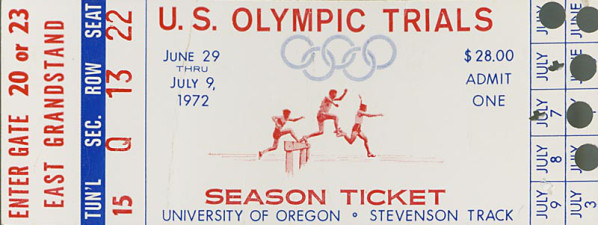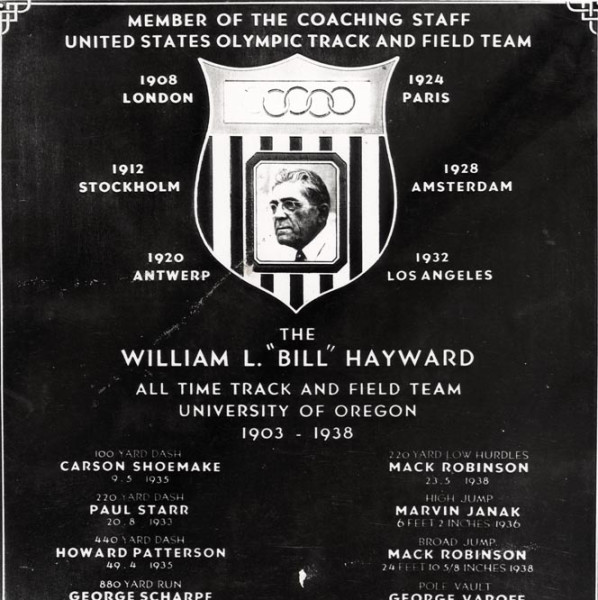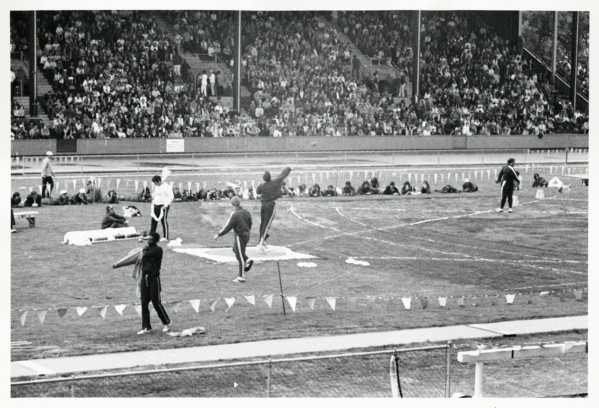An International Challenge
Olympians
As the only site to host three consecutive U.S. Olympic Trials (1972, 1976, 1980), Eugene has a long-held reputation as the center of track and field in the U.S. Hosting the 2008 and 2012 U.S. Olympic Team Trials extends this tradition. Two major components contribute to the strong relationship between the University of Oregon and the Olympic Games: Oregon’s student-athlete Olympians and Olympic events held in Eugene.
 Oregon Olympians: International Ducks
Oregon Olympians: International Ducks
In 1908, Dan Kelly captured Oregon’s first Olympic medal, winning silver in the broad jump. Since that first feat at the Games in London, England, at least one UO athlete has participated in the summer Olympics each year it was held.
Diverse in talents and capabilities, Oregon’s roster of Olympians also spans the globe. As Oregon became a reputable track and field institution, international student-athletes flocked to join the team. Many of these athletes went on to compete for their home countries in multiple Olympic Games. In fact, in several Olympic Games, the international roster of Oregon student-athletes, competing for their native countries, surpassed the Duck representation on the American team. For example, in 1976, 11 athletes from the University participated in the Games; seven of the 11 competed for other countries. Even when the United States boycotted the 1980 Olympic Games, Oregon’s Chris Braithwaite competed for his native Trinidad.
Oregon student-athletes and the Olympic Games have teamed up for a century. From Ralph Hill’s courageous run in 1932 that pegged him the “Hero of the Games” to Piotrek Buciarski’s determined pole vault efforts during the 2004 Games that left him out of medal contention, Oregon athletes embraced the entire Olympic experience from victories to disappointments. They overcame the odds and helped put themselves and the University of Oregon on the list of Olympic competitors.
 Olympic Events at Oregon: The Best in the World
Olympic Events at Oregon: The Best in the World
With the emergence of running greats such as Dyrol Burleson and Bill Dellinger, Oregon began to mold its reputation in the 1950s and 60s as a hot-bed of track and field talent. The first major Olympic-caliber meet took place during Labor Day Weekend in 1956. The Eugene Active Club, in conjunction with the UO Athletic Department and the U.S. Olympic Committee (USOC), held the U.S. Olympic Track Team Exhibition Meet at Hayward Field. The event showcased premier athletes and served as a training event prior to the 1956 Melbourne Games. Nearly 12,000 spectators came to the meet. It was so successful that a second exhibition meet was held at Oregon prior to the 1960 Games.
Oregon hosted its first U.S. Olympic Trials in 1972. The 10-day event drew 140,100 spectators. At the time, the mark ranked third in total attendance ever for an American meet, behind the 1932 Olympics in Los Angeles and the 1962 USA-USSR meet at Stanford.
After the rave reviews of the 1972 Trials, Eugene was a shoo-in for the 1976 U.S. Olympic Track and Field Trials. For the first time in history, the organizing committee offered travel pay and a per diem for athletes who qualified for the meet. Attendance surpassed the 1972 Trials, and the meet grossed nearly $200,000 for the USOC after all expenses.
 As track and field gained popularity throughout the country, competition to host the 1980 U.S. Olympic Trials escalated. Oregon narrowly edged out Durham, North Carolina, by one vote, marking the third consecutive Trials awarded to the area. Despite the threat of a U.S. Olympic boycott, advanced ticket sales for the Trials reached an all-time high, and Oregon greats Bill McChesney, Jr. and Leann Warren ran away with stellar performances. Hayward Field remains the only venue to host three U.S. Olympic Trials in a row.
As track and field gained popularity throughout the country, competition to host the 1980 U.S. Olympic Trials escalated. Oregon narrowly edged out Durham, North Carolina, by one vote, marking the third consecutive Trials awarded to the area. Despite the threat of a U.S. Olympic boycott, advanced ticket sales for the Trials reached an all-time high, and Oregon greats Bill McChesney, Jr. and Leann Warren ran away with stellar performances. Hayward Field remains the only venue to host three U.S. Olympic Trials in a row.
The U.S. Track and Field Olympic Trials returned to Eugene in 2008 to sold-out crowds, with electrifying performances by the University of Oregon’s Nick Symmonds, Andrew Wheating, and Christian Smith, who finished 1-2-3 in the 800-meter finals. The 2012 Olympic Team Trials at Hayward Field promises to add new layers to the university’s rich Olympic heritage.
Fun Facts
- Vying for the 1988 Trials, Eugene lost the event to Indianapolis, allegedly due to major renovations needed at Hayward Field. Among the estimated $3.5 million improvements needed were converting the track from 440-yards to 400-meters and revamping the east grandstand. Because of University budget cuts, Oregon Track Club members sought assistance from the community to raise $1.9 million. After the renovations were completed in 1988, Hayward Field hosted four NCAA Championships.
- Bill Bowerman served as head coach for the 1972 U.S. Track and Field Olympic Team. Prior to that, Bowerman had been instrumental in establishing a high-altitude training program for the team. He also served on the USOC Board of Directors and assisted on other U.S. Olympic Track and Field teams. A passionate advocate for athletes, Bowerman continually fought for athletes’ rights-often criticizing the AAU for not treating the American athletes adequately. Bowerman also played a leading role in establishing the U.S. Track Team Exhibition Meets in Eugene in addition to assisting with the Olympic Trials bids and preparations.
- In addition to competing in three Olympics, Bill Dellinger served as the distance coach on the 1984 U.S. Track and Field Olympic team.
- The Olympic Creed: “The most important thing in the Olympic Games is not to win but to take part, just as the most important thing in life is not the triumph but the struggle. The essential thing is not to have conquered but to have fought well.”
- The University became a target for financial assistance for the U.S. Olympic team in 1924. Prior to the Pacific Coast Conference Championships in Eugene, Robert M. Thompson, President of the American Olympic Committee, sent the President of the University of Oregon a Western Union Telegram on May 24 asking the school to solicit funds from students to defray expenses of the American Olympic Team in Paris. The American Olympic Committee (AOC) petitioned for funds across the nation in hopes of raising $350,000 for the 350-person team. Since more than 70 percent of the U.S. team members were university students, the AOC believed that soliciting funds from other college students was a logical move. The AOC eventually reached its funding goal by the end of the Games in Melbourne, Australia.
- Canadian Bill Hayward played multiple roles on the U.S. Track and Field staff, assisting in six different Olympic Games.
- The 1956 U.S. Olympic Exhibition Meet developed from an idea Dr. Ralph P. Christenson, a Eugene physician, had for arranging a Junior Olympics event. As planning ensued, the event transformed into a pre-Olympic meet. The competition marked the first time Hayward Field hosted an event of this size. It was also the first meet at Hayward that used metric measurements.
- In the 1972 Olympic Track and Field Team Report by George M. Wilson, Head Manager Wilson wrote in reference to the Eugene Trials: “I doubt if there has ever been one [a U.S. Olympic Trials] better in all respects.”
- “Eugene’s bid proposes an unprecedented focus on athletes, and plans for celebrating the sport that will make it a great fan experience. Hayward Field is hallowed ground in our sport and Eugene’s vision for what they can do to connect track’s past, present and future won the day.” Craig Masback, Chief Executive Officer USA Track & Field October 14, 2005
- In 1960, the University of Oregon had more athletes on the U.S. Olympic team than any other intercollegiate institution.